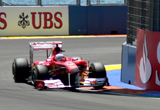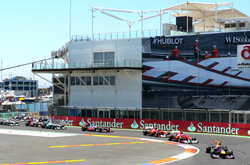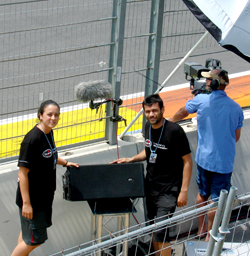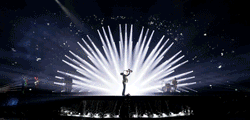 When the Formula One European Grand Prix returned to Valencia, the Spanish town gave its full attention, and local sound company Sagarmanta Producciones turned to DAS Audio systems for the extensive grandstand areas.
When the Formula One European Grand Prix returned to Valencia, the Spanish town gave its full attention, and local sound company Sagarmanta Producciones turned to DAS Audio systems for the extensive grandstand areas.
The company called on more than 30 technicians to set up sound for the 14 grandstands around the circuit using CobraNet distribution.
In all, more than 150,000 spectators were drawn to the Valencia Street Circuit over the testing, qualifying sessions and the race itself, it was an intense weekend. For them, the grandstands were the centre of activity, with 85,000 spectators attending on race day alone. The weather was kind and they enjoyed a typically Mediterranean day at the waterfront track.
The challenges presented by an event of this scale are considerable. For a start, the circuit is more than 5km long and simply installing the required number of loudspeaker cabinets is a major task. Setting up the electrical supply and distribution of the sound signal to more than 115 cabinets supplied by DAS Audio for this event, as well as the management of this signal, was a major undertaking.
 The team also installed individual automatic signal systems for each grandstand in case of emergency evacuation, as well as providing the technical expertise for sound for the podium and award presentation areas.
The team also installed individual automatic signal systems for each grandstand in case of emergency evacuation, as well as providing the technical expertise for sound for the podium and award presentation areas.
The cabinets used throughout the sound installation were DAS Aero 12A self-powered line array systems. These met the various challenges posed by the different grandstand configurations and their locations...
Around the circuit, some of the stands were completely straight, others were curved, some had 20 rows of seats, others had more than 40; the central forum was covered, the rest of the area wasn’t... Clearly, a number of solutions and set-ups were rquired.
The first physical inconvenience was the impossibility of situating the systems above the protection wall that surrounds the track, since the security regulations in motor competitions prevent placing solid elements above the wall. To overcome this, especially in the higher stands, the work-around Sagarmanta Producciones adopted was to set the angle of systems according to their locations relative to the zone of influence of each.
The units were placed on truss-type structured podia, whose angles could be adjusted through the arrangement of two vertical threaded shafts. This made it possible to place the systems with different angles of inclination according to the needs of each location, and this was the determining factor in giving coverage to the upper areas, especially in the highest stands with more than 40 rows of seats. The more than 115 total units placed around the circuit had an average distance of 8-10m between each. There were also 15 extra or back-up units on hand in case of any incident – but were not needed.
 For the electrical feed, each of the different stands had a single phase 16A/20A connection, which was distributed to all the subsequent systems and used to power the active DAS Audio systems.
For the electrical feed, each of the different stands had a single phase 16A/20A connection, which was distributed to all the subsequent systems and used to power the active DAS Audio systems.
Another technical consideration was the adjustment of the high-frequency band of the systems to compensate for the use of line array boxes as a distributed system – 6dB cut was used in the 2.7kHz band to obtain a flat response from each of the elements. This allowed a more uniform sound delivery, since line array systems are designed to be used in linear formations of six or eight units.
Another key feature of the installation was the method used for distributing the signal to each of the systems around the circuit – a fibre-optic line more than 2km. This network had its focal point in a control centre in the pit stop area, from which 16 different sends were carried by CobraNet to the grandstand and award presentation areas. The entire audio signal needed to be independent for each area, and a fibre-optic ring that linked a series of nodes, which in turn formed a star with different link points. Through a VLAN, receivers in each of the stands identified the appropriate sugnal and relayed it to the systems. The result was unified signal management that minimised the delays between adjacent stands, as well as possible synchronisation problems between the most remote areas.
Not only was the 2011 Grand Prix challenge was met with creative solutions and successfully overcome, the experience paves the way for future F1 European Grand Prix events at the Valencia Street Circuit.
More: www.sagarmanta.com
More: dasaudio.com












